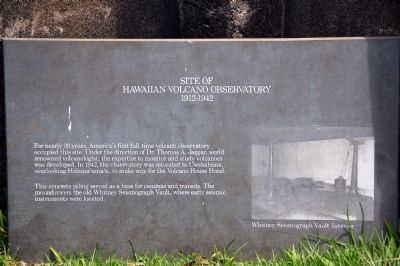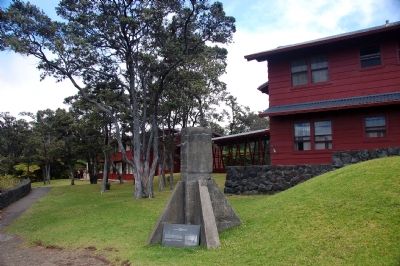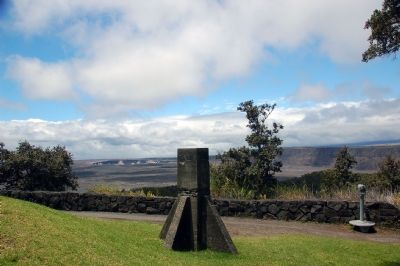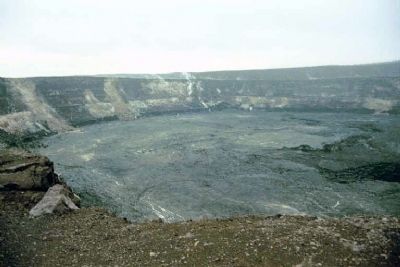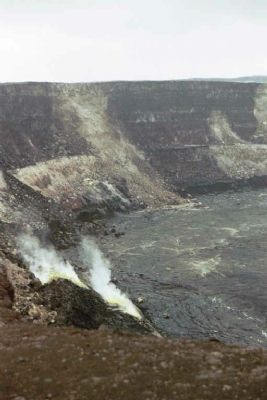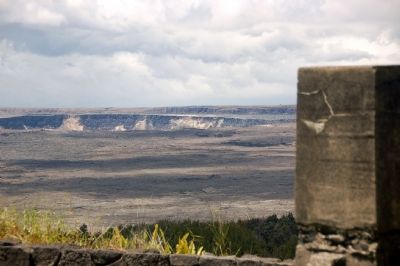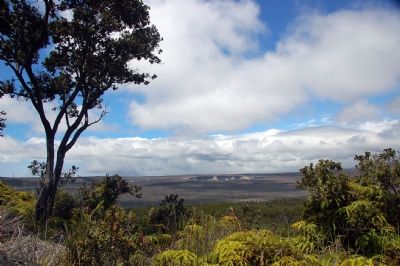Volcano in Hawaii County, Hawaii — Hawaiian Island Archipelago (Pacific Ocean)
Site of Hawaiian Volcano Observatory
1912-1942
For nearly 30 years, America’s first full-time volcano observatory occupied this site. Under the direction of Dr. Thomas A. Jaggar, world renowned volcanologist, the expertise to monitor and study volcanoes was developed. In 1942, the observatory was relocated to Uwekahuna, overlooking Haema’uma’u, to make way for the Volcano House Hotel.
This concrete piling served as a base for cameras and transits. The mound covers the old Whitney Seismograph Vault, where early seismic instruments were located.
Topics. This historical marker is listed in these topic lists: Environment • Industry & Commerce. A significant historical year for this entry is 1942.
Location. 19° 25.747′ N, 155° 15.497′ W. Marker is in Volcano, Hawaii, in Hawaii County. Marker is behind the vistor center. Touch for map. Marker is in this post office area: Volcano HI 96785, United States of America. Touch for directions.
Other nearby markers. At least 8 other markers are within 2 miles of this marker, measured as the crow flies. The Volcano House reigns as one of America's great lodges (within shouting distance of this marker); The 'Ōhi'a Wing will soon be home to the park's collection of artwork and artifacts (within shouting distance of this marker); Kilauea (about 400 feet away, measured in a direct line); Countless are the Accomplishments of Roosevelt's Trusty "Tree Army" (about 400 feet away); Stephen Tyng Mather (about 400 feet away); Hawaii Volcanoes National Park (about 400 feet away); Explosive eruptions rock Kīlauea volcano (approx. 1.7 miles away); Mauna Loa (approx. 2.1 miles away). Touch for a list and map of all markers in Volcano.
More about this marker. Photo caption: Whitney Seismograph Vault Interior
Also see . . . USGS Hawaiian Volcano Observatory. Observatory homepage (Submitted on October 15, 2007, by Karen Key of Sacramento, California.)
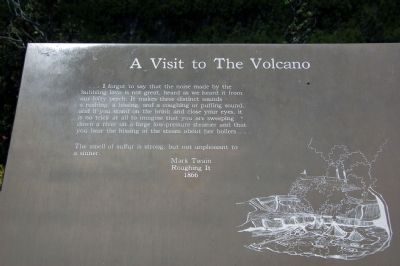
Photographed By Karen Key, September 1, 2007
7. A Visit to The Volcano
... I forgot to say that the noise made by the bubbling lava is not great, heard as we heard it from our lofty perch. It makes three distinct sounds - a rushing; a hissing, and a coughing or puffing sound, and if you stand on the brink and close your eyes, it is no trick at all to imagine that you are sweeping down a river on a large low-pressure steamer and that you hear the hissing of the steam about her boilers ...
The smell of sulfur is strong, but not unpleasant to a sinner.
Mark Twain, Roughing It, 1866
The smell of sulfur is strong, but not unpleasant to a sinner.
Mark Twain, Roughing It, 1866
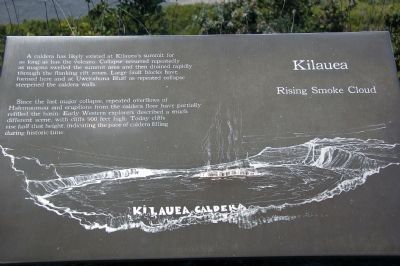
Photographed By Karen Key, September 1, 2007
8. Kilauea, Rising Smoke Cloud
A caldera has likely existed at Kilauea's summit for as long as has the volcano. Collapse occurred repeatedly as magma swelled the summit area and then drained rapidly through the flanking rift zones. large fault blocks have formed here and at Uwekahuna Bluff as repeated collapse steepened the caldera walls.
Since the last major collapse, repeated overflows of Halemaumau and eruptions from the caldera floor have partially refilled the basin. Early Western explorers described a much different scene, with cliffs 900 feet high. Today cliffs rise half that height, indicating the pace of caldera filling during historic time.
Since the last major collapse, repeated overflows of Halemaumau and eruptions from the caldera floor have partially refilled the basin. Early Western explorers described a much different scene, with cliffs 900 feet high. Today cliffs rise half that height, indicating the pace of caldera filling during historic time.
Credits. This page was last revised on April 5, 2021. It was originally submitted on October 15, 2007, by Karen Key of Sacramento, California. This page has been viewed 1,951 times since then and 23 times this year. Photos: 1, 2, 3. submitted on October 15, 2007, by Karen Key of Sacramento, California. 4, 5. submitted on January 4, 2008, by Mike Stroud of Bluffton, South Carolina. 6, 7, 8, 9. submitted on October 15, 2007, by Karen Key of Sacramento, California. • J. J. Prats was the editor who published this page.
